Evaluating Hydrological Processes of the Atmosphere–Vegetation Interaction Model and MERRA-2 at Global Scale
Abstract
1. Introduction
2. Model, Data, and Methodology
2.1. Model Introduction
2.2. Data and Methodology
3. Results
3.1. Surface Runoff
3.2. Surface Soil Moisture
3.3. Evapotranspiration
3.4. Discussion
4. Conclusions
Author Contributions
Funding
Institutional Review Board Statement
Informed Consent Statement
Data Availability Statement
Acknowledgments
Conflicts of Interest
References
- Song, C.; Yuan, L.; Yang, X.; Fu, B. Ecological-hydrological processes in arid environment: Past, present and future. J. Geogr. Sci. 2017, 27, 1577–1594. [Google Scholar] [CrossRef]
- Santanello, J.A., Jr.; Dirmeyer, P.A.; Ferguson, C.R.; Findell, K.L.; Tawfik, A.B.; Berg, A.; Ek, M.; Gentine, P.; Guillod, B.P.; Van Heerwaarden, C. Land–atmosphere interactions: The loco perspective. Bull. Am. Meteorol. Soc. 2018, 99, 1253–1272. [Google Scholar] [CrossRef]
- Pitman, A.J.; McAvaney, B.J. The role of surface energy balance complexity in land surface models’ sensitivity to increasing carbon dioxide. Clim. Dyn. 2002, 19, 609–618. [Google Scholar]
- Pitman, A.J. The evolution of, and revolution in, land surface schemes designed for climate models. Int. J. Climatol. J. R. Meteorol. Soc. 2003, 23, 479–510. [Google Scholar] [CrossRef]
- Crossley, J.; Polcher, J.; Cox, P.; Gedney, N.; Planton, S. Uncertainties linked to land-surface processes in climate change simulations. Clim. Dyn. 2000, 16, 949–961. [Google Scholar] [CrossRef]
- Dan, L.; Ji, J.; Li, Y. Climatic and biological simulations in a two-way coupled atmosphere–biosphere model (cabm). Glob. Planet. Chang. 2005, 47, 153–169. [Google Scholar] [CrossRef]
- Zabel, F. Land-Atmosphere Coupling between a Land Surface Hydrological Model and a regional Climate Model. Doctoral thesis, LMU München, München, Germany, 2012. [Google Scholar]
- Intergovernmental Panel on Climate Change (IPCC). Climate Change 2014-Impacts, Adaptation and Vulnerability: Part a: Global and Sectoral Aspects: Volume 1, Global and Sectoral Aspects: Working Group ii Contribution to the Ipcc Fifth Assessment Report; Cambridge University Press: Cambridge, UK, 2014. [Google Scholar]
- Fang, G.; Yang, J.; Chen, Y.; Li, Z.; De Maeyer, P. Impact of gcm structure uncertainty on hydrological processes in an arid area of china. Hydrol. Res. 2018, 49, 893–907. [Google Scholar] [CrossRef]
- Seneviratne, S.I.; Corti, T.; Davin, E.L.; Hirschi, M.; Jaeger, E.B.; Lehner, I.; Orlowsky, B.; Teuling, A.J. Investigating soil moisture–climate interactions in a changing climate: A review. Earth-Sci. Rev. 2010, 99, 125–161. [Google Scholar] [CrossRef]
- Dorigo, W.; Wagner, W.; Albergel, C.; Albrecht, F.; Balsamo, G.; Brocca, L.; Chung, D.; Ertl, M.; Forkel, M.; Gruber, A. Esa cci soil moisture for improved earth system understanding: State-of-the art and future directions. Remote Sens. Environ. 2017, 203, 185–215. [Google Scholar] [CrossRef]
- McColl, K.A.; Alemohammad, S.H.; Akbar, R.; Konings, A.G.; Yueh, S.; Entekhabi, D. The global distribution and dynamics of surface soil moisture. Nat. Geosci. 2017, 10, 100–104. [Google Scholar] [CrossRef]
- Crow, W.; Chen, F.; Reichle, R.; Xia, Y.; Liu, Q. Exploiting soil moisture, precipitation, and streamflow observations to evaluate soil moisture/runoff coupling in land surface models. Geophys. Res. Lett. 2018, 45, 4869–4878. [Google Scholar] [CrossRef] [PubMed]
- van der Molen, M.K.; Dolman, A.J.; Ciais, P.; Eglin, T.; Gobron, N.; Law, B.E.; Meir, P.; Peters, W.; Phillips, O.L.; Reichstein, M. Drought and ecosystem carbon cycling. Agric. For. Meteorol. 2011, 151, 765–773. [Google Scholar] [CrossRef]
- Oki, T.; Kanae, S. Global hydrological cycles and world water resources. Science 2006, 313, 1068–1072. [Google Scholar] [CrossRef] [PubMed]
- Trenberth, K.E.; Fasullo, J.T.; Kiehl, J. Earth’s global energy budget. Bull. Am. Meteorol. Soc. 2009, 90, 311–324. [Google Scholar] [CrossRef]
- Findell, K.L.; Gentine, P.; Lintner, B.R.; Kerr, C. Probability of afternoon precipitation in eastern united states and mexico enhanced by high evaporation. Nat. Geosci. 2011, 4, 434–439. [Google Scholar] [CrossRef]
- Taylor, C.M.; de Jeu, R.A.; Guichard, F.; Harris, P.P.; Dorigo, W.A. Afternoon rain more likely over drier soils. Nature 2012, 489, 423–426. [Google Scholar] [CrossRef]
- Guillod, B.P.; Orlowsky, B.; Miralles, D.G.; Teuling, A.J.; Seneviratne, S.I. Reconciling spatial and temporal soil moisture effects on afternoon rainfall. Nat. Commun. 2015, 6, 1–6. [Google Scholar] [CrossRef]
- Ciais, P.; Reichstein, M.; Viovy, N.; Granier, A.; Ogée, J.; Allard, V.; Aubinet, M.; Buchmann, N.; Bernhofer, C.; Carrara, A. Europe-wide reduction in primary productivity caused by the heat and drought in 2003. Nature 2005, 437, 529–533. [Google Scholar] [CrossRef]
- Fischer, E.M.; Seneviratne, S.I.; Lüthi, D.; Schär, C. Contribution of land—Atmosphere coupling to recent european summer heat waves. Geophys. Res. Lett. 2007, 34. [Google Scholar] [CrossRef]
- Hirschi, M.; Seneviratne, S.I.; Alexandrov, V.; Boberg, F.; Boroneant, C.; Christensen, O.B.; Formayer, H.; Orlowsky, B.; Stepanek, P. Observational evidence for soil-moisture impact on hot extremes in southeastern europe. Nat. Geosci. 2011, 4, 17–21. [Google Scholar] [CrossRef]
- Miralles, D.G.; Teuling, A.J.; Van Heerwaarden, C.C.; De Arellano, J.V.-G. Mega-heatwave temperatures due to combined soil desiccation and atmospheric heat accumulation. Nat. Geosci. 2014, 7, 345–349. [Google Scholar] [CrossRef]
- Mueller, B.; Seneviratne, S.I. Hot days induced by precipitation deficits at the global scale. Proc. Natl. Acad. Sci. USA 2012, 109, 12398–12403. [Google Scholar] [CrossRef]
- Kuhl, S.C.; Miller, J.R. Seasonal river runoff calculated from a global atmospheric model. Water Resour. Res. 1992, 28, 2029–2039. [Google Scholar] [CrossRef]
- Lu, J.; Ji, J. A simulation and mechanism analysis of long-Term variations at land surface over arid/semi-arid area in north china. J. Geophys. Res. Atmos. 2006, 111. [Google Scholar] [CrossRef]
- Dan, L.; Ji, J.; Zhang, P. The soil moisture of china in a high resolution climate-vegetation model. Adv. Atmos. Sci. 22, 720–729.
- Ji, J. A climate-vegetation interaction model: Simulating physical and biological processes at the surface. J. Biogeogr. 1995, 22, 445–451. [Google Scholar] [CrossRef]
- Ji, J.; Hu, Y. A simple land surface process model for use in climate study. Acta Meteorol. Sin. 1989, 3, 342–351. [Google Scholar]
- Dan, L.; Ji, J.; He, Y. Use of islscp ii data to intercompare and validate the terrestrial net primary production in a land surface model coupled to a general circulation model. J. Geophys. Res. Atmos. 2007, 112. [Google Scholar] [CrossRef]
- Dan, L.; Cao, F.; Gao, R. The improvement of a regional climate model by coupling a land surface model with eco-physiological processes: A case study in 1998. Clim. Chang. 2015, 129, 457–470. [Google Scholar] [CrossRef]
- Li, Y.; Ji, J. Model estimates of global carbon flux between vegetation and the atmosphere. Adv. Atmos. Sci. 2001, 18, 807–818. [Google Scholar]
- Dan, L.; Ji, J.; Li, Y. Climate simulations based on a different-grid nested and coupled model. Adv. Atmos. Sci. 2002, 19, 487–499. [Google Scholar]
- Lu, J.; Ji, J. A simulation study of atmosphere-vegetation interactions over the tibetan plateau part i: Physical fluxes and parameters. Chin. J. Atmos. Sci. 2002, 26, 111–126. [Google Scholar]
- Lv, M.; Lu, H.; Yang, K.; Xu, Z.; Lv, M.; Huang, X. Assessment of runoff components simulated by gldas against unh–grdc dataset at global and hemispheric scales. Water 2018, 10, 969. [Google Scholar] [CrossRef]
- Rodell, M.; Houser, P.; Jambor, U.; Gottschalck, J.; Mitchell, K.; Meng, C.-J.; Arsenault, K.; Cosgrove, B.; Radakovich, J.; Bosilovich, M. The global land data assimilation system. Bull. Am. Meteorol. Soc. 2004, 85, 381–394. [Google Scholar] [CrossRef]
- Fekete, B.M.; Vörösmarty, C.J.; Grabs, W. Global Composite Runoff Fields Based on Observed River Discharge and Simulated Water Balances; University of New Hampshire: Durham, NH, USA, 2000. [Google Scholar]
- Fekete, B.M.; Vörösmarty, C.J.; Grabs, W. High-resolution fields of global runoff combining observed river discharge and simulated water balances. Glob. Biogeochem. Cycles 2002, 16, 15-1–15-10. [Google Scholar] [CrossRef]
- Cai, X.; Yang, Z.L.; David, C.H.; Niu, G.Y.; Rodell, M. Hydrological evaluation of the noah-mp land surface model for the mississippi river basin. J. Geophys. Res. Atmos. 2015, 119, 23–38. [Google Scholar] [CrossRef]
- Liu, Y.; Dorigo, W.A.; Parinussa, R.; de Jeu, R.A.; Wagner, W.; McCabe, M.F.; Evans, J.; Van Dijk, A. Trend-preserving blending of passive and active microwave soil moisture retrievals. Remote Sens. Environ. 2012, 123, 280–297. [Google Scholar] [CrossRef]
- Gruber, A.; Dorigo, W.A.; Crow, W.; Wagner, W. Triple collocation-based merging of satellite soil moisture retrievals. IEEE Trans. Geosci. Remote Sens. 2017, 55, 6780–6792. [Google Scholar] [CrossRef]
- Gruber, A.; Scanlon, T.; van der Schalie, R.; Wagner, W.; Dorigo, W. Evolution of the esa cci soil moisture climate data records and their underlying merging methodology. Earth Syst. Sci. Data 2019, 11, 717–739. [Google Scholar] [CrossRef]
- Miralles, D.G.; Jeu, R.A.M.D.; Gash, J.H.; Holmes, T.R.H.; Dolman, A.J. An application of gleam to estimating global evaporation. Hydrol. Earth Syst. Sci. Discuss. 2011, 8, 1–27. [Google Scholar] [CrossRef]
- Martens, B.; Gonzalez Miralles, D.; Lievens, H.; Van Der Schalie, R.; De Jeu, R.A.; Fernández-Prieto, D.; Beck, H.E.; Dorigo, W.; Verhoest, N. Gleam v3: Satellite-based land evaporation and root-zone soil moisture. Geosci. Model Dev. 2017, 10, 1903–1925. [Google Scholar] [CrossRef]
- Rienecker, M.M.; Suarez, M.J.; Gelaro, R.; Todling, R.; Bacmeister, J.; Liu, E.; Bosilovich, M.G.; Schubert, S.D.; Takacs, L.; Kim, G.-K. Merra: Nasa’s modern-era retrospective analysis for research and applications. J. Clim. 2011, 24, 3624–3648. [Google Scholar] [CrossRef]
- Gelaro, R.; McCarty, W.; Suárez, M.J.; Todling, R.; Molod, A.; Takacs, L.; Randles, C.A.; Darmenov, A.; Bosilovich, M.G.; Reichle, R. The modern-era retrospective analysis for research and applications, version 2 (merra-2). J. Clim. 2017, 30, 5419–5454. [Google Scholar] [CrossRef] [PubMed]
- Wang, F.; Wang, L.; Koike, T.; Zhou, H.; Yang, K.; Wang, A.; Li, W. Evaluation and application of a fine-resolution global data set in a semiarid mesoscale river basin with a distributed biosphere hydrological model. J. Geophys. Res. Atmos. 2011, 116. [Google Scholar] [CrossRef]
- Wang, A.; Zeng, X. Evaluation of multireanalysis products with in situ observations over the tibetan plateau. J. Geophys. Res. Atmos. 2012, 117. [Google Scholar] [CrossRef]
- Wang, W.; Cui, W.; Wang, X.; Chen, X. Evaluation of gldas-1 and gldas-2 forcing data and noah model simulations over china at the monthly scale. J. Hydrometeorol. 2016, 17, 2815–2833. [Google Scholar] [CrossRef]
- Yang, F.; Lu, H.; Yang, K.; He, J.; Wang, W.; Wright, J.S.; Li, C.; Han, M.; Li, Y. Evaluation of multiple forcing data sets for precipitation and shortwave radiation over major land areas of china. Hydrol. Earth Syst. Sci. 2017, 21, 5805–5821. [Google Scholar] [CrossRef]
- Rui, H.; Beaudoing, H. Readme Document for the Global Land Data Assimilation System Version 2 (Gldas-2) Products; Nasa Goddard Earth Sciences Data and Information Services Center: Greenbelt, MD, USA, 2014. [Google Scholar]
- Zhou, X.; Zhang, Y.; Yang, Y.; Yang, Y.; Han, S. Evaluation of anomalies in gldas-1996 dataset. Water Sci. Technol. 2013, 67, 1718–1727. [Google Scholar] [CrossRef]
- Ma, H.; Zeng, J.; Chen, N.; Zhang, X.; Cosh, M.H.; Wang, W. Satellite surface soil moisture from smap, smos, amsr2 and esa cci: A comprehensive assessment using global ground-based observations. Remote Sens. Environ. 2019, 231, 111215. [Google Scholar] [CrossRef]
- An, R.; Zhang, L.; Wang, Z.; Quaye-Ballard, J.A.; You, J.; Shen, X.; Gao, W.; Huang, L.; Zhao, Y.; Ke, Z. Validation of the esa cci soil moisture product in china. Int. J. Appl. Earth Obs. Geoinf. 2016, 48, 28–36. [Google Scholar] [CrossRef]
- Chakravorty, A.; Chahar, B.R.; Sharma, O.P.; Dhanya, C. A regional scale performance evaluation of smos and esa-cci soil moisture products over india with simulated soil moisture from merra-land. Remote Sens. Environ. 2016, 186, 514–527. [Google Scholar] [CrossRef]
- Dorigo, W.; Gruber, A.; De Jeu, R.; Wagner, W.; Stacke, T.; Loew, A.; Albergel, C.; Brocca, L.; Chung, D.; Parinussa, R. Evaluation of the esa cci soil moisture product using ground-based observations. Remote Sens. Environ. 2015, 162, 380–395. [Google Scholar] [CrossRef]
- Khan, M.S.; Liaqat, U.W.; Baik, J.; Choi, M. Stand-alone uncertainty characterization of gleam, gldas and mod16 evapotranspiration products using an extended triple collocation approach. Agric. For. Meteorol. 2018, 252, 256–268. [Google Scholar] [CrossRef]
- Miralles, D.G.; Jiménez, C.; Jung, M.; Michel, D.; Ershadi, A.; McCabe, M.; Hirschi, M.; Martens, B.; Dolman, A.J.; Fisher, J.B. The wacmos-et project-part 2: Evaluation of global terrestrial evaporation data sets. Hydrol. Earth Syst. Sci. 2016, 20, 823–842. [Google Scholar] [CrossRef]
- Yang, X.; Yong, B.; Ren, L.; Zhang, Y.; Long, D. Multi-scale validation of gleam evapotranspiration products over china via chinaflux et measurements. Int. J. Remote Sens. 2017, 38, 5688–5709. [Google Scholar] [CrossRef]
- Reichle, R.H.; Draper, C.S.; Liu, Q.; Girotto, M.; Mahanama, S.P.; Koster, R.D.; De Lannoy, G.J. Assessment of merra-2 land surface hydrology estimates. J. Clim. 2017, 30, 2937–2960. [Google Scholar] [CrossRef]
- Bosilovich, M.G.; Akella, S.; Coy, L.; Cullather, R.; Draper, C.; Gelaro, R.; Kovach, R.; Liu, Q.; Molod, A.; Norris, P. Merra-2: Initial Evaluation of the Climate; NASA Technical Report Series on Global Modeling and Data Assimilation, NASA/TM-2015-104606; National Aeronautics and Space Administration, Goddard Space Flight Center: Greenbelt, MD, USA, 2015; Volume 43, 139p.
- Bosilovich, M.G.; Robertson, F.R.; Takacs, L.; Molod, A.; Mocko, D. Atmospheric water balance and variability in the merra-2 reanalysis. J. Clim. 2017, 30, 1177–1196. [Google Scholar] [CrossRef]
- Draper, C.S.; Reichle, R.H.; Koster, R.D. Assessment of merra-2 land surface energy flux estimates. J. Clim. 2018, 31, 671–691. [Google Scholar] [CrossRef]


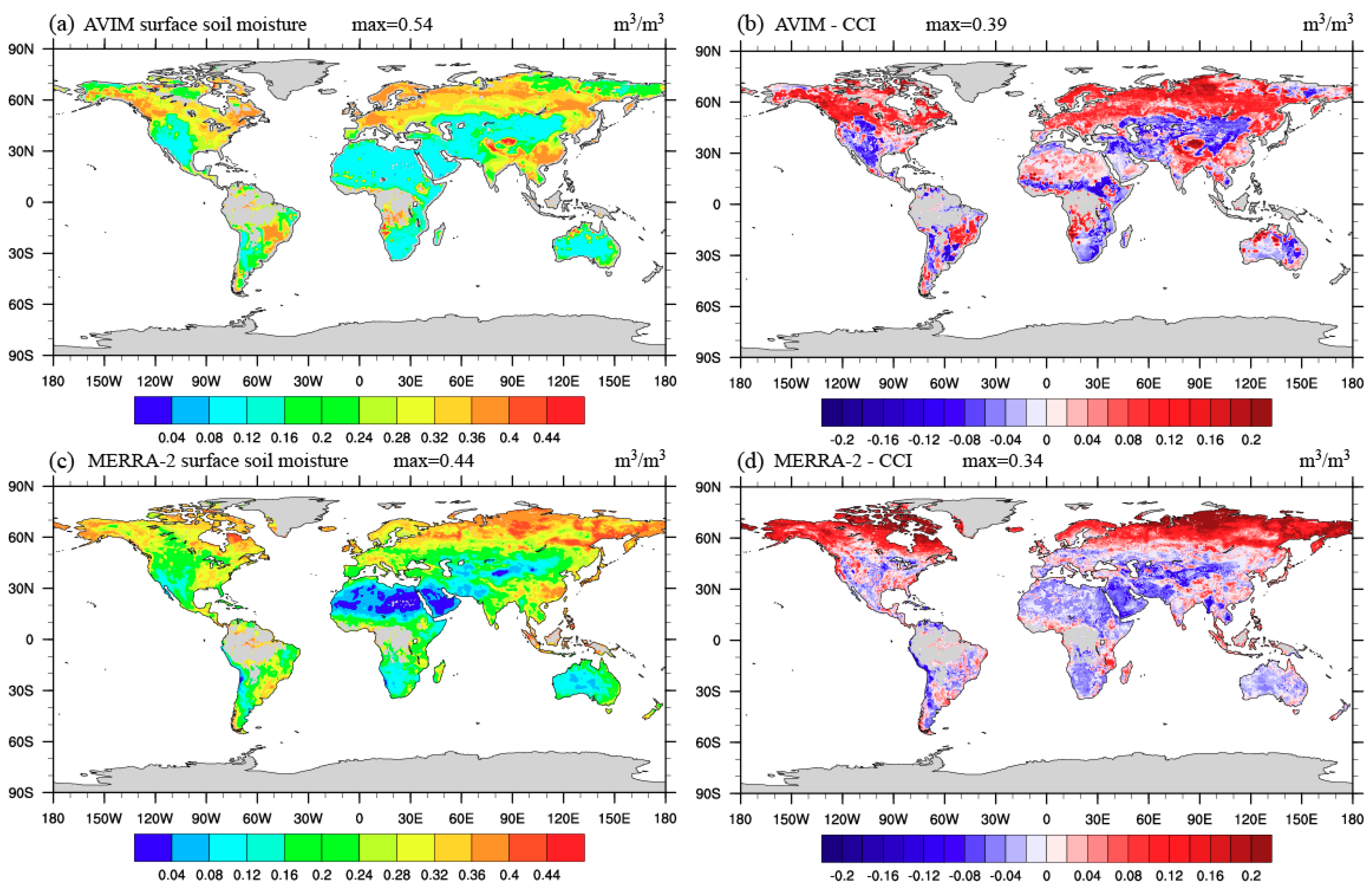
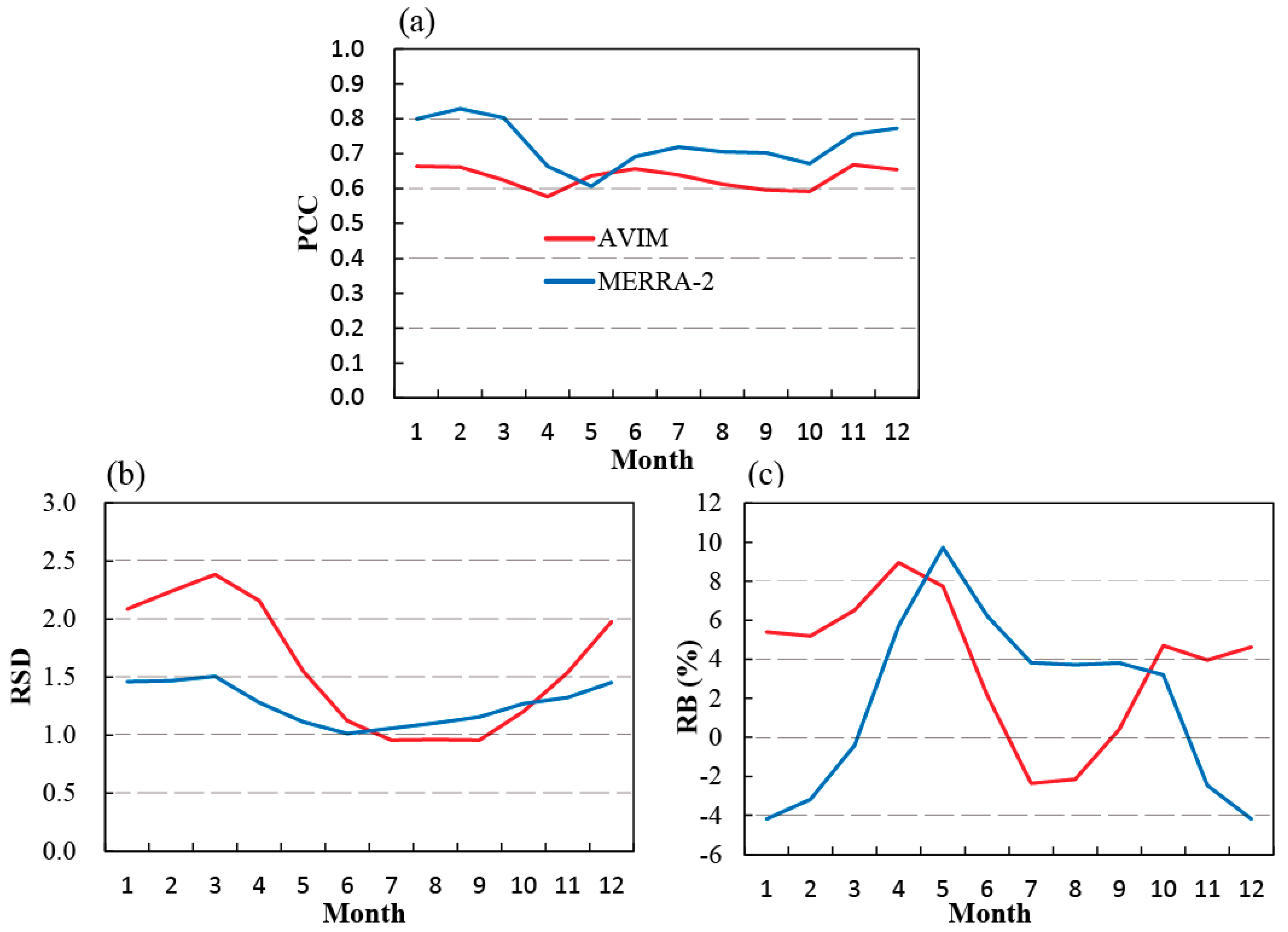
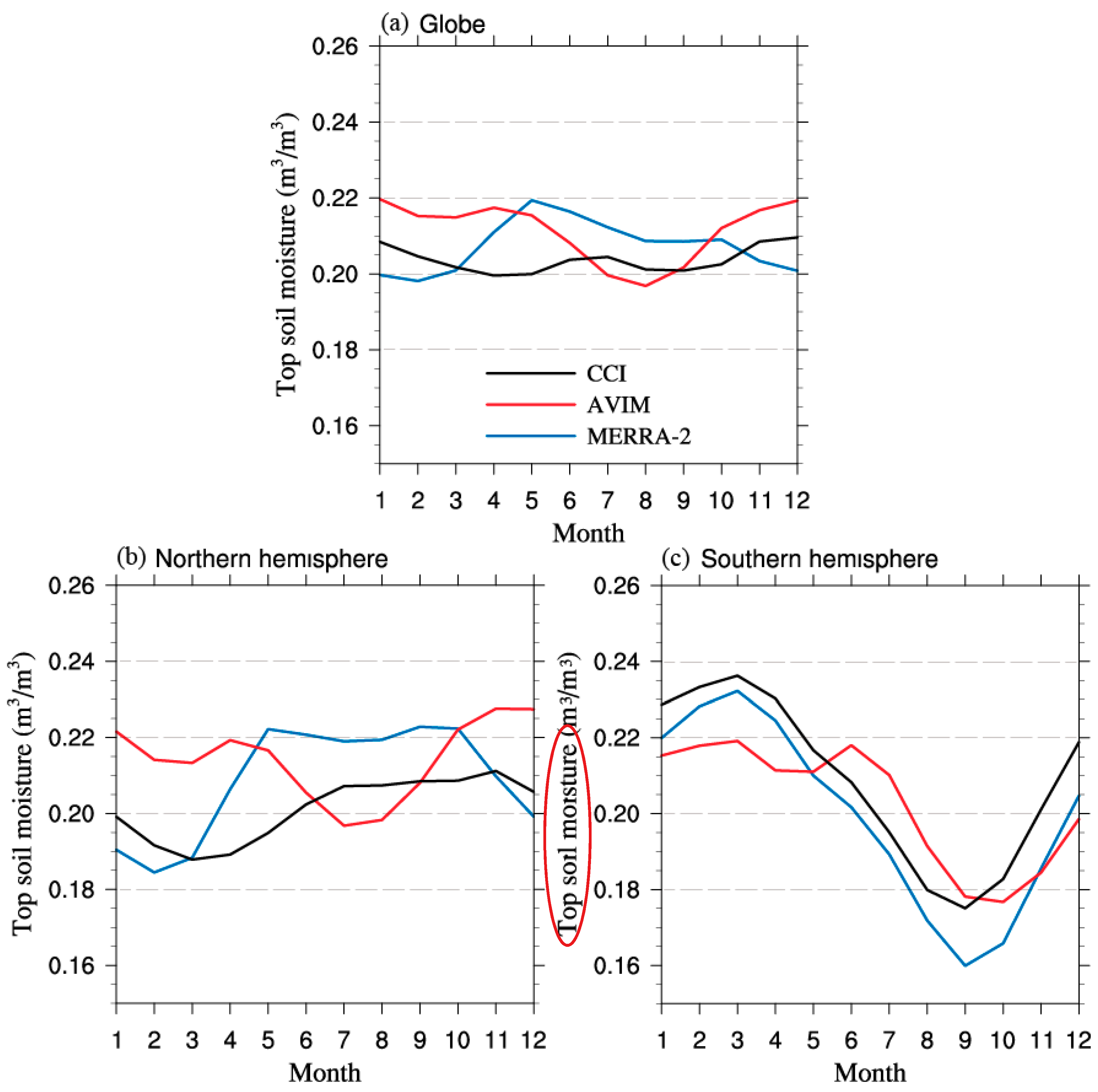
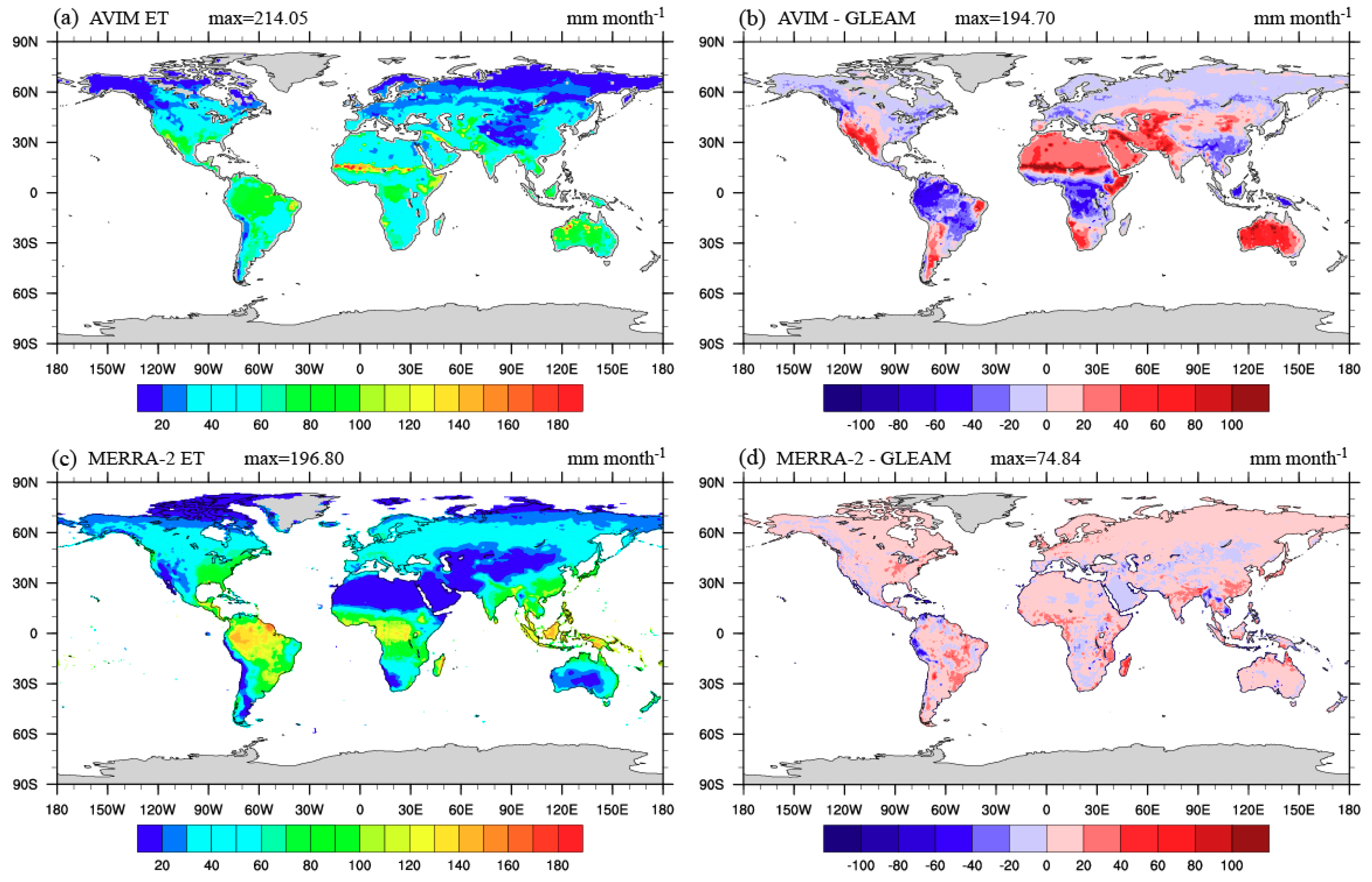
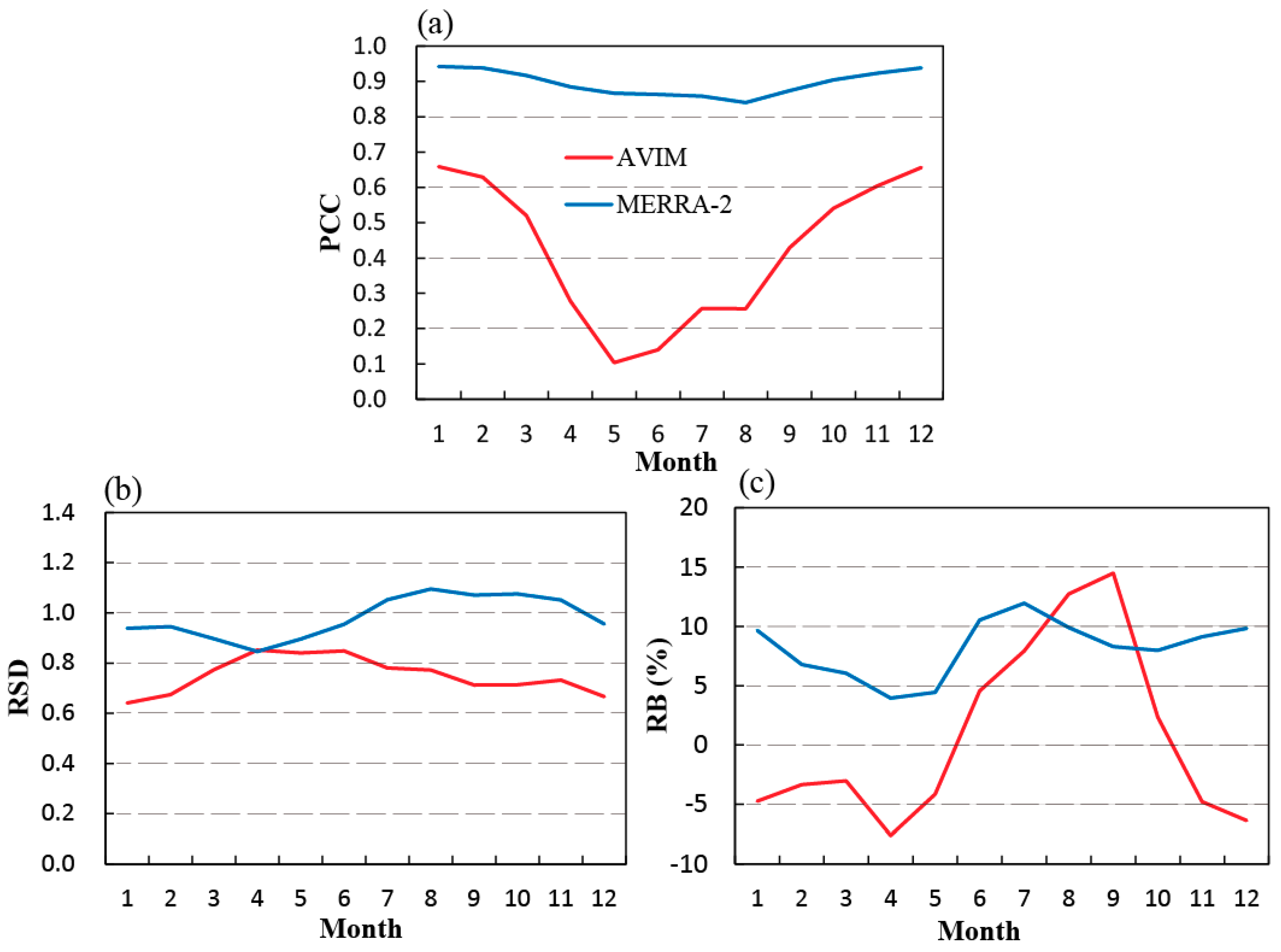
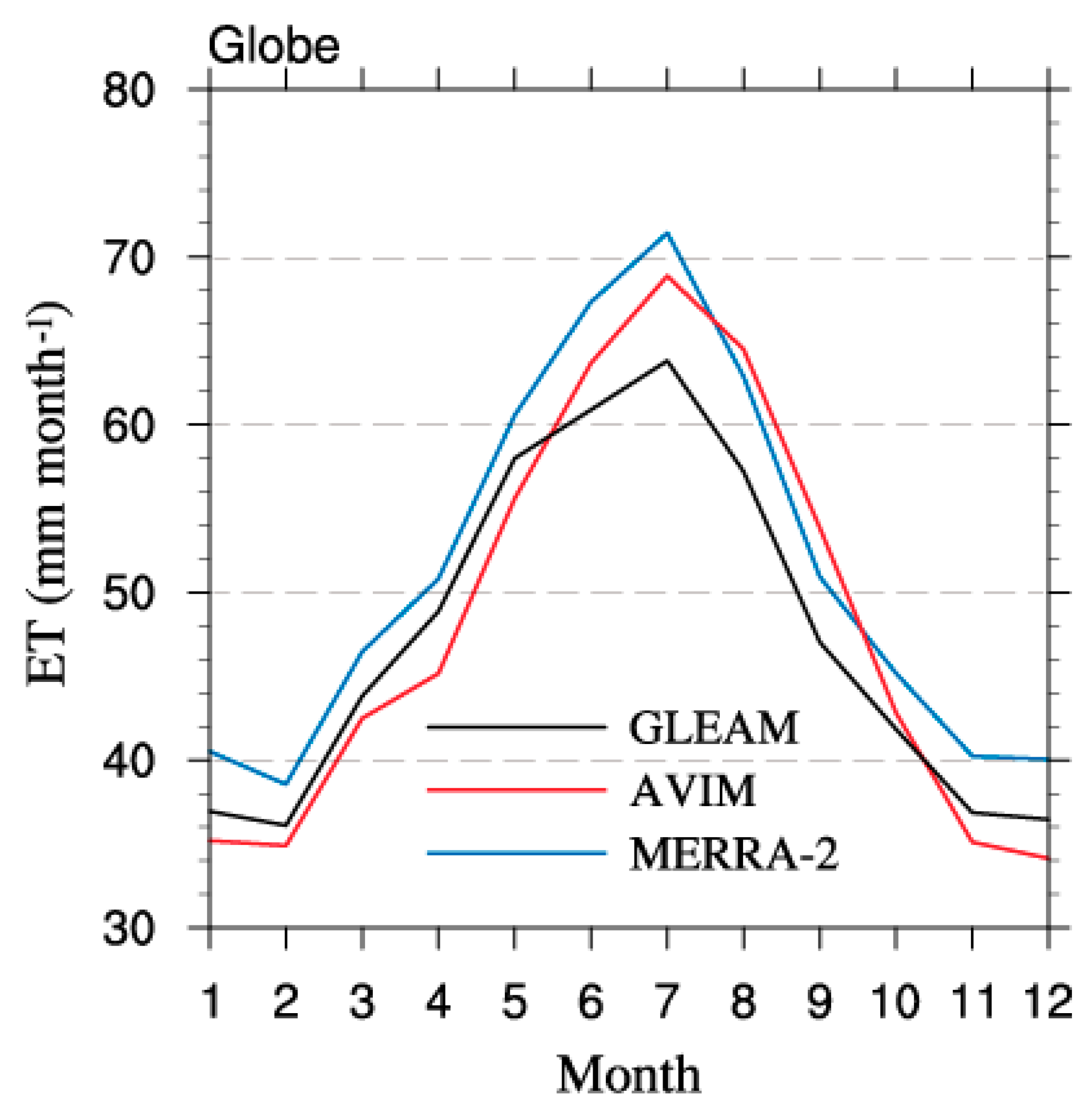
| Global Datasets | Forcing Data | Surface Runoff | Total Runoff | Surface Soil Moisture | Evapotranspiration |
|---|---|---|---|---|---|
| GLDAS 1.0-CLM, VIC, and Noah (1.0° × 1.0°) | √ | √ | |||
| GLDAS 2.1-Noah (0.25° × 0.25°) | √ | ||||
| UNH-GRDC V1.0 (0.5° × 0.5°) | √ | ||||
| GLEAM V3.3a (0.25° × 0.25°) | √ | ||||
| CCI COMBINED V04.7 (0.25° × 0.25°) | √ | ||||
| MERRA-2 (0.5° × 0.625°) | √ | √ |
Publisher’s Note: MDPI stays neutral with regard to jurisdictional claims in published maps and institutional affiliations. |
© 2020 by the authors. Licensee MDPI, Basel, Switzerland. This article is an open access article distributed under the terms and conditions of the Creative Commons Attribution (CC BY) license (http://creativecommons.org/licenses/by/4.0/).
Share and Cite
Lv, M.; Xu, Z.; Lv, M. Evaluating Hydrological Processes of the Atmosphere–Vegetation Interaction Model and MERRA-2 at Global Scale. Atmosphere 2021, 12, 16. https://doi.org/10.3390/atmos12010016
Lv M, Xu Z, Lv M. Evaluating Hydrological Processes of the Atmosphere–Vegetation Interaction Model and MERRA-2 at Global Scale. Atmosphere. 2021; 12(1):16. https://doi.org/10.3390/atmos12010016
Chicago/Turabian StyleLv, Meizhao, Zhongfeng Xu, and Meixia Lv. 2021. "Evaluating Hydrological Processes of the Atmosphere–Vegetation Interaction Model and MERRA-2 at Global Scale" Atmosphere 12, no. 1: 16. https://doi.org/10.3390/atmos12010016
APA StyleLv, M., Xu, Z., & Lv, M. (2021). Evaluating Hydrological Processes of the Atmosphere–Vegetation Interaction Model and MERRA-2 at Global Scale. Atmosphere, 12(1), 16. https://doi.org/10.3390/atmos12010016





